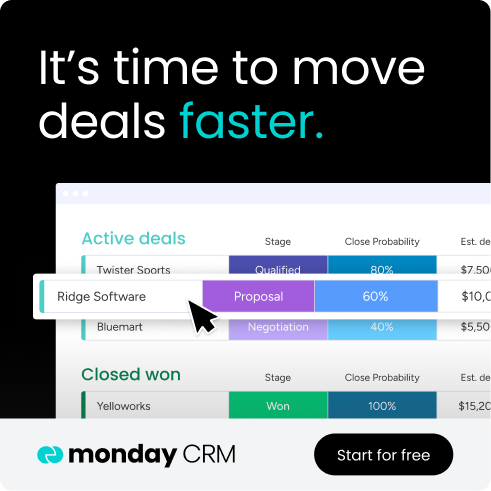Your business may be doing everything right to craft memorable marketing campaigns and smooth sales processes, but if you’re only measuring customer satisfaction through periodic surveys, you’re likely missing what customers are actually experiencing in real time.
Now, customer tracking goes beyond collecting feedback after the fact. It connects behavior, sentiment, and journey data across every touchpoint, helping teams understand not just how customers feel, but why — and when to act.
In this guide, we’ll break down what customer tracking really means, how it differs from satisfaction and experience tracking, which metrics matter most, and how real-time insights and AI-powered tools like monday CRM help teams identify issues earlier, respond faster, and continuously improve the customer experience across the entire journey.
What is customer tracking?
Customer tracking is the practice of collecting and analyzing data across customer interactions, behaviors, and touchpoints to understand how customers engage with your business over time. Rather than focusing on a single moment or score, customer tracking brings together behavioral, sentiment, and journey data to reveal patterns that influence satisfaction, retention, and loyalty.
By gathering this information, businesses put themselves in a better position to offer more tailored customer experiences. Not only that, but customer tracking is a way to gather essential data that can inform marketing strategies and improve decision-making.
What are the different types of customer tracking?
It’s easy to get mixed up between different ways to track your customers, so let’s set the record straight. The table below outlines the differences between each approach and explains why each one plays an important role.
These terms are often used interchangeably, but they serve different purposes. Understanding how each type of tracking works — and how they complement one another — is essential for building a complete view of the customer experience.
| Customer tracking | Customer satisfaction tracking | Customer experience tracking | Customer journey tracking | |
|---|---|---|---|---|
| What it tracks | Behavior | Happiness | Feeling | Path |
| Definition | Covers all types of tracking to monitor customer data and behavior across interactions | Measures how happy and satisfied customers are with products, services, or interactions | Looks at the full customer journey from first touchpoint to post-purchase | Maps every touchpoint across a customer lifecycle from pre-sale to retention |
| Focus | Collect behavioral data | Understand customer sentiment and satisfaction | Map the customer’s emotional journey over time | Track progression through stages to identify how experiences connect |
| What it measures | Purchases, website activity, email opens, product usage, demographics, interaction history | Happiness, matched expectations, frustration or delight | Complete journey narrative, friction points, seamless interactions across channels | Stage progression, conversion rates between phases, drop-off points, time in each stage |
| Key metrics | Conversion rates, engagement metrics, purchase frequency, customer lifetime value | Net promoter score, customer satisfaction score, customer effort score | Journey completion rates, touchpoint satisfaction, emotional sentiment at each stage | Conversion rates per stage, average time to conversion, abandonment rates, milestone completion |
| Main distinction | Data collection | Measuring happiness | Understanding the overall experience | Mapping lifecycle progression and stage transitions |
While each approach delivers value on its own, organizations see the greatest impact when they’re used together. Customer tracking provides the behavioral foundation, satisfaction tracking measures fulfillment levels, experience tracking adds emotional context across touchpoints, and journey tracking shows how it all connects across the lifecycle. Together, they offer a well-rounded view that helps businesses understand not just what customers are feeling, but why.
Core customer satisfaction metrics to measure
Information about your customers is everywhere, from support tickets to emails and even website analytics. The trick is gathering the right data points to paint an accurate picture of overall customer satisfaction so that you can create an actionable plan for improvements. A good way to do this is to track specific metrics, such as the ones below.
- Customer satisfaction surveys (CSAT): One of the best ways to track customer satisfaction is simply to turn to your customers. Create questionnaires you can send to your customers to gather feedback on your performance and gauge their satisfaction. CSAT works best for evaluating specific interactions, such as support tickets or onboarding moments, rather than long-term loyalty.
- Net promoter score (NPS): A good way to understand how happy your customers are is to see how likely they are to recommend your business to others. To measure your NPS, ask customers about their likelihood to recommend so you can sort them as promoters, passives, or detractors to your brand. NPS is most useful as a trend metric over time, not a one-off indicator.
- Customer effort score (CES): Tracking CES is a good way to track satisfaction with support. To measure CES, ask customers to rank how much effort they felt they had to invest to get an issue solved, address a pain point, or reach a goal with your business. CES is especially valuable for identifying friction in support and self-service experiences.
- Churn rate: Looking at how many customers leave in a predetermined period of time can give you insights into how loyal they are to your brand and how satisfied they are with your products or services. While churn is a lagging indicator, tracking it alongside real-time signals helps teams intervene earlier.
Aside from measuring metrics, you should also get into a regular habit of combing through popular review sites and online forums to get a peek into what customers are sharing about you indirectly. Social listening is also important, as it enables businesses to monitor customer sentiment on social media channels and track sensitive comments that have the ability to go viral.
How to identify and analyze customer pain points
While sending surveys and scouring the internet and social media for reviews is helpful, it’s highly likely you already have a ton of customer satisfaction data, and you just don’t know it. The way customers communicate with your business can say a lot about how happy they are with your services. Let’s break it down.
Uncover pain points in everyday interactions
Customer pain points often hide in plain sight. Support tickets, chat logs, email exchanges, and call transcripts contain valuable clues about customer frustrations. Look for patterns in the issues customers report most often, questions that repeat, and problems that require multiple touchpoints to resolve. Not only do these patterns reveal what’s not working, but also where your customer experience is falling short.
Leverage sentiment analysis to gauge emotional responses
Beyond what customers say, how they say it matters just as much. Sentiment analysis tools can automatically evaluate the tone and emotion behind customer communications, flagging negative sentiment that might otherwise go unnoticed. By monitoring sentiment trends, you can spot emerging issues before they escalate and understand which aspects of your service generate the strongest positive or negative reactions.
Turn feedback into actionable improvement plans
Collecting data is only the first step. The real value comes from translating insights into concrete action. Start by categorizing feedback and prioritizing recurring themes based on frequency and impact on customer satisfaction. For each pain point, develop specific and measurable improvement initiatives with clear timelines. Finally, communicate changes back to customers, showing them their feedback led to real improvements, so that you build trust and encourage ongoing engagement.
4 core features to look for when choosing customer tracking software
While customer tracking software tools vary widely, effective platforms share a core set of capabilities. The following features enable teams to move beyond isolated data points and build a unified, real-time understanding of customer satisfaction and experience.
- Data unification across touchpoints: Your tracking software should consolidate customer data from all channels, whether that’s support tickets, social media, surveys, or emails, so that everything exists in one unified view, eliminating silos and offering a complete view of the customer story.
- Real-time visibility: The customer tracking platform you choose needs to give you real-time visibility into how your customers feel with detailed dashboards, reporting tools, and instant updates on metrics.
- Automations and alerts: Find a platform that offers simple automations that can alert team members to low satisfaction scores, follow-up reminders, and that can engage customers with automated messaging.
- AI-assisted analysis: Having insights into your current customer data is helpful, but it will only take you so far. The solution should also leverage AI to give you more detailed and future-focused analytics, including forecasting and risk assessment, so that you can work more proactively.
Should you use a CRM or a specialized tracking app?
When it comes to selecting the right platform to track customer satisfaction, you have options. Based on what you want to focus on most, you might opt for a specialized sales tracking solution or an all-in-one CRM to track metrics while also managing customer relationships. There are also platforms for surveys and social listening, which can be beneficial for teams that want to focus on specific aspects of customer satisfaction tracking.
A CRM makes it simple to keep all your customer data under one roof. Even if you use different apps like social listening tools and survey platforms, you can integrate them with a CRM to combine workflows. A platform like monday CRM will help provide real-time insights that give you a complete picture of customer health rather than a fragmented view of a specific platform. For example, customer surveys may show high satisfaction levels, but customers are showing frustration through emails and other channels.
For teams looking to track customer satisfaction across multiple channels and act on insights quickly, a CRM often serves as the central system that connects feedback, behavior, and workflows into a single source of truth.
Try monday CRMThe benefits of real-time customer experience tracking
Traditional satisfaction tracking relies on historical data. Real-time customer experience tracking adds immediacy, allowing teams to respond to changes in behavior or sentiment as they happen, not weeks later.
There are a lot of perks to measuring the customer experience, especially when you’re working with real-time metrics. According to Forrester, when companies invest in improving the brand and customer experience, they can achieve up to 3.5x revenue growth while driving increased customer retention and loyalty.
Still, the advantages extend beyond just improving customer experience and can truly transform the way your business functions. Let’s take a look at some of the main ways businesses stand to benefit from customer tracking.
- Promote proactive customer engagement: Instead of working reactively, real-time customer tracking helps your business intervene when it matters most to avoid customer churn. For example, with a platform that offers real-time alerts and sentiment analysis tools, you can get notified when a customer expresses frustration in a message and immediately address or escalate the issue rather than waiting.
- Improve customer retention rates: When you track satisfaction in real-time, you can identify customers who are at risk of churn and address their concerns immediately. According to a KPMG study, even a 2-3% increase in retention rates can lead to a significant increase in revenue and profitability.
- Boost your bottom line: When you track customer satisfaction and take action to improve the customer experience, your clients are more likely to stay loyal to your company and make repeat purchases.
- Change behavior with real-time signals: Sending periodic surveys is a great way to collect feedback, but sometimes a customer’s experience can change in an instant. With real-time experience tracking tools, you can get alerted to a change in behavior, like a drop in product usage or repeated support tickets, and adjust your engagement and outreach strategies to address your customer’s current behavior.
- Streamline product development: The data you gather from surveys and metrics can influence decisions your business needs to make about new product developments and improvements, leading to more streamlined offerings that align with customer preferences.
- Enhance brand reputation: When your customers are happy, they become advocates for your brand who turn others onto your brand through word-of-mouth, which is also a cost-effective method of marketing your business.
- Improve employee satisfaction: Happy customers lead to happy employees. When teams can see how their work directly impacts customer satisfaction, it creates a sense of purpose and accountability, boosting morale and accountability.
AI changes customer tracking from a reactive process into a proactive one. Instead of manually reviewing surveys or dashboards, teams can rely on AI to surface patterns, flag risks, and prioritize issues automatically — helping them focus attention where it matters most, before dissatisfaction turns into churn.
Unlocking customer loyalty with monday CRM
CRMs offer an all-around solution that tackles customer satisfaction from every angle, from nurturing new leads to engaging clients to solicit ongoing purchases and establish a deep sense of customer loyalty. A platform like monday CRM helps teams gather critical information on their customers and then use it to inform sales strategy, marketing campaigns, and customer satisfaction initiatives.
Powered by advanced AI and automation capabilities, monday CRM is a suitable solution for businesses of any size and in any industry. The platform’s AI makes it simple to generate high-level reports in seconds and create workflows to streamline regular feedback collection. Additionally, monday CRM’s customizable dashboards and flexible workflows allow teams to tailor the platform to their specific needs, so every metric that matters most is visible.
Here’s a look at some of monday CRM’s features that make it ideal for measuring customer satisfaction.
Integrate all the tools you need
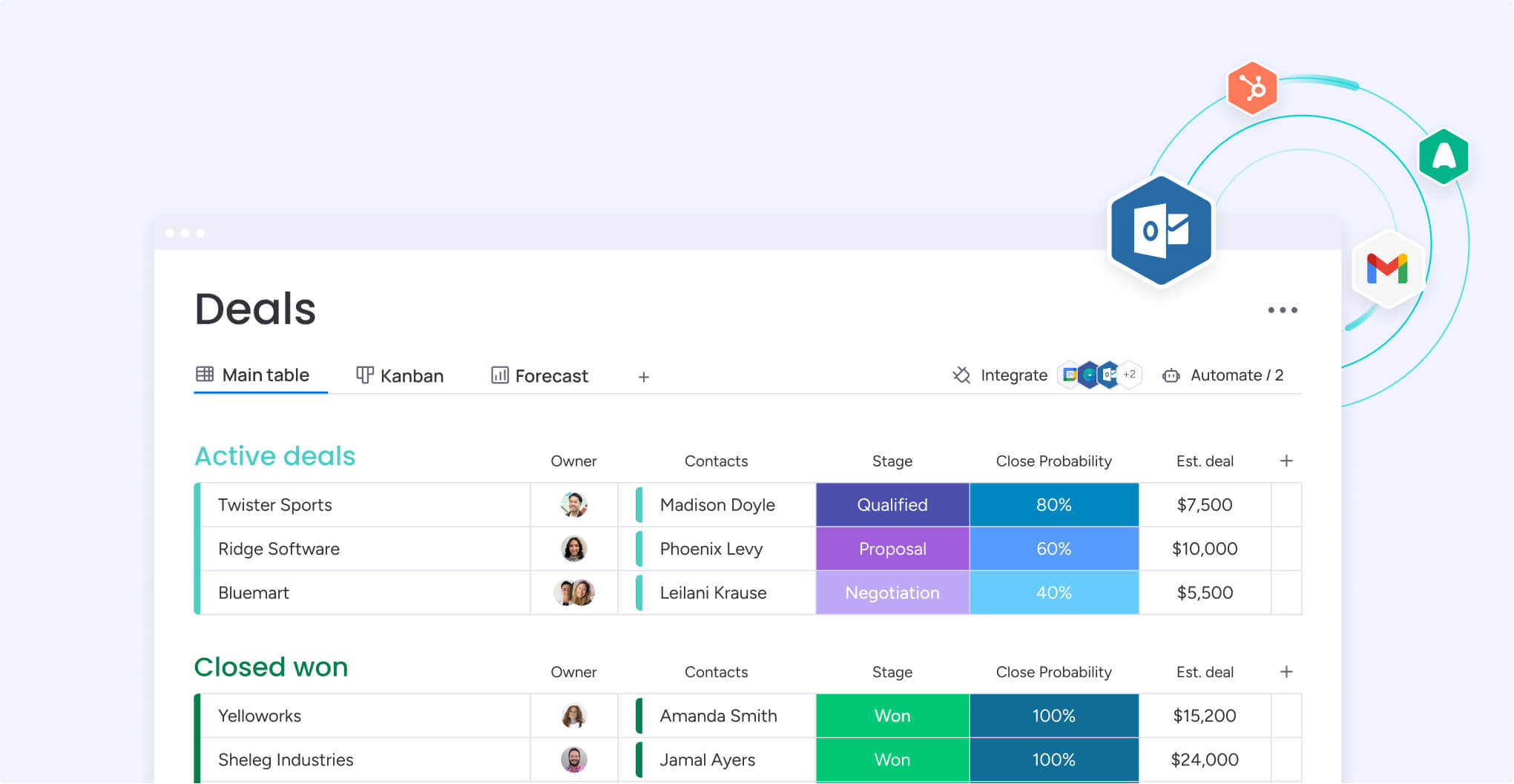
With monday CRM, teams have access to over 200 different app integrations, making it easy to keep everything under one roof. Teams can integrate platforms like SurveyMonkey, various social platforms, HootSuite, and others to sync data and automations between platforms.
AI-powered data analysis
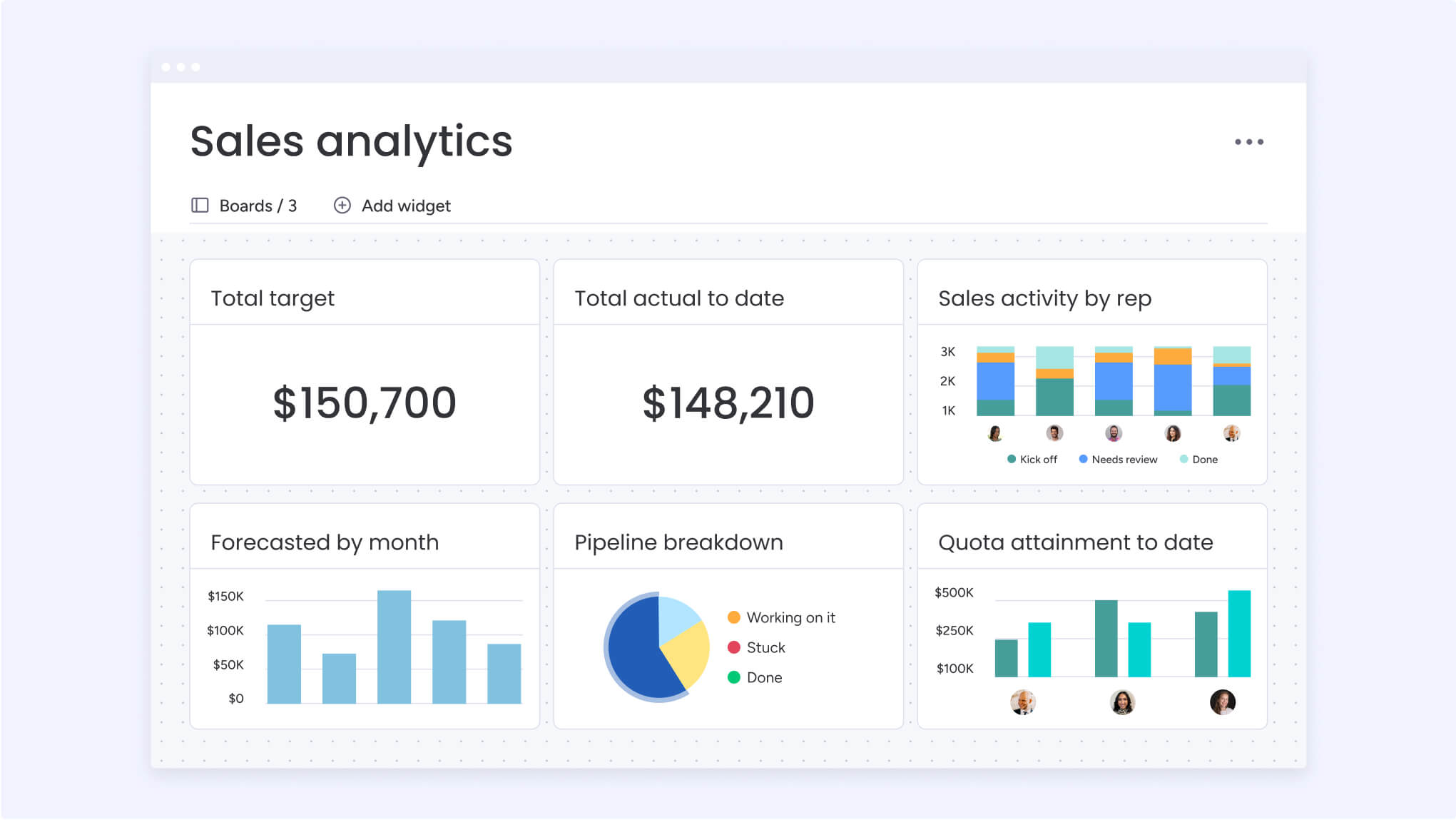
Optimize reporting and data analytics with the platform’s CRM analytics and AI capabilities. Businesses can use the platform’s AI to generate real-time reports to track satisfaction metrics at regular intervals, as well as uncover hidden patterns in customer behavior with predictive analytics to see potential churn risks before they materialize.
Automate customer retention initiatives with AI
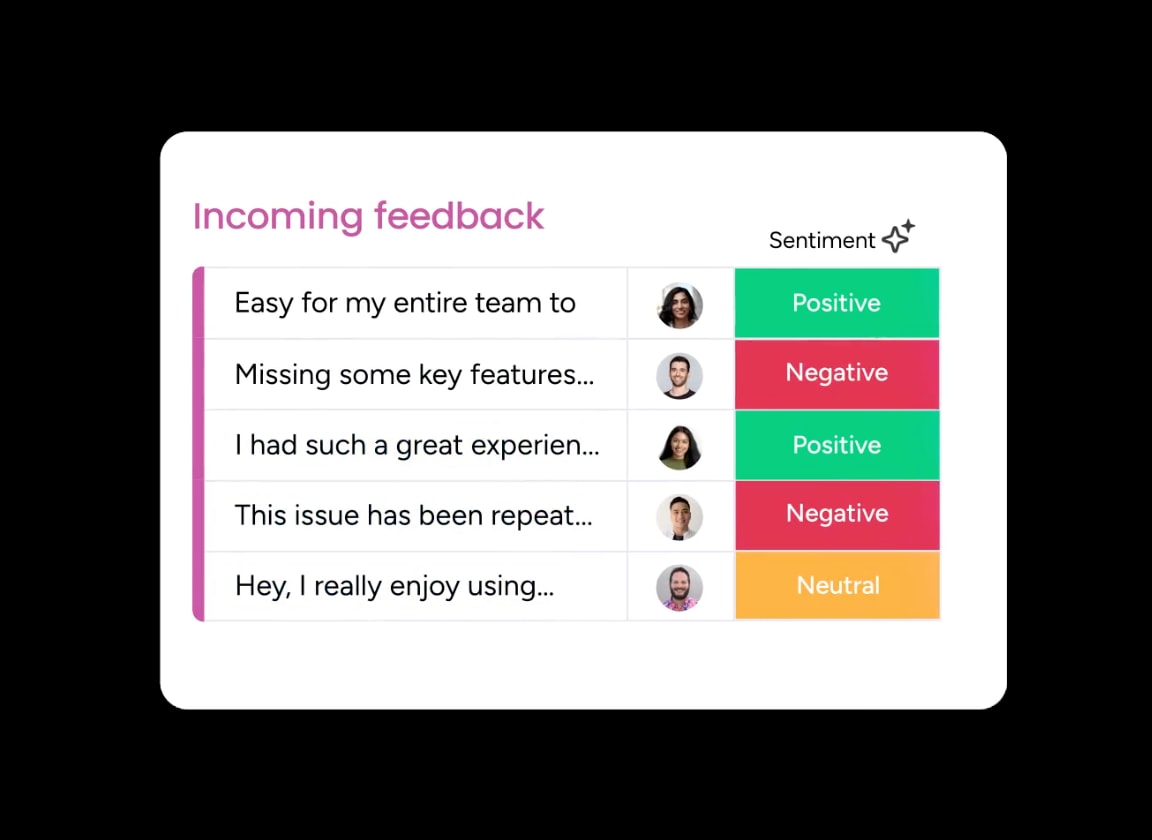
Teams can rely on monday CRM’s built-in AI to automate various aspects of communication and service. You can use AI to automate follow-ups and alerts to improve customer response times to service requests. AI can also facilitate sentiment analysis at scale so that your CRM is always on the lookout for negative sentiment in all your incoming messages, allowing you to take quick action and prioritize clients who show dissatisfaction.
Visualize satisfaction with AI and smart dashboards
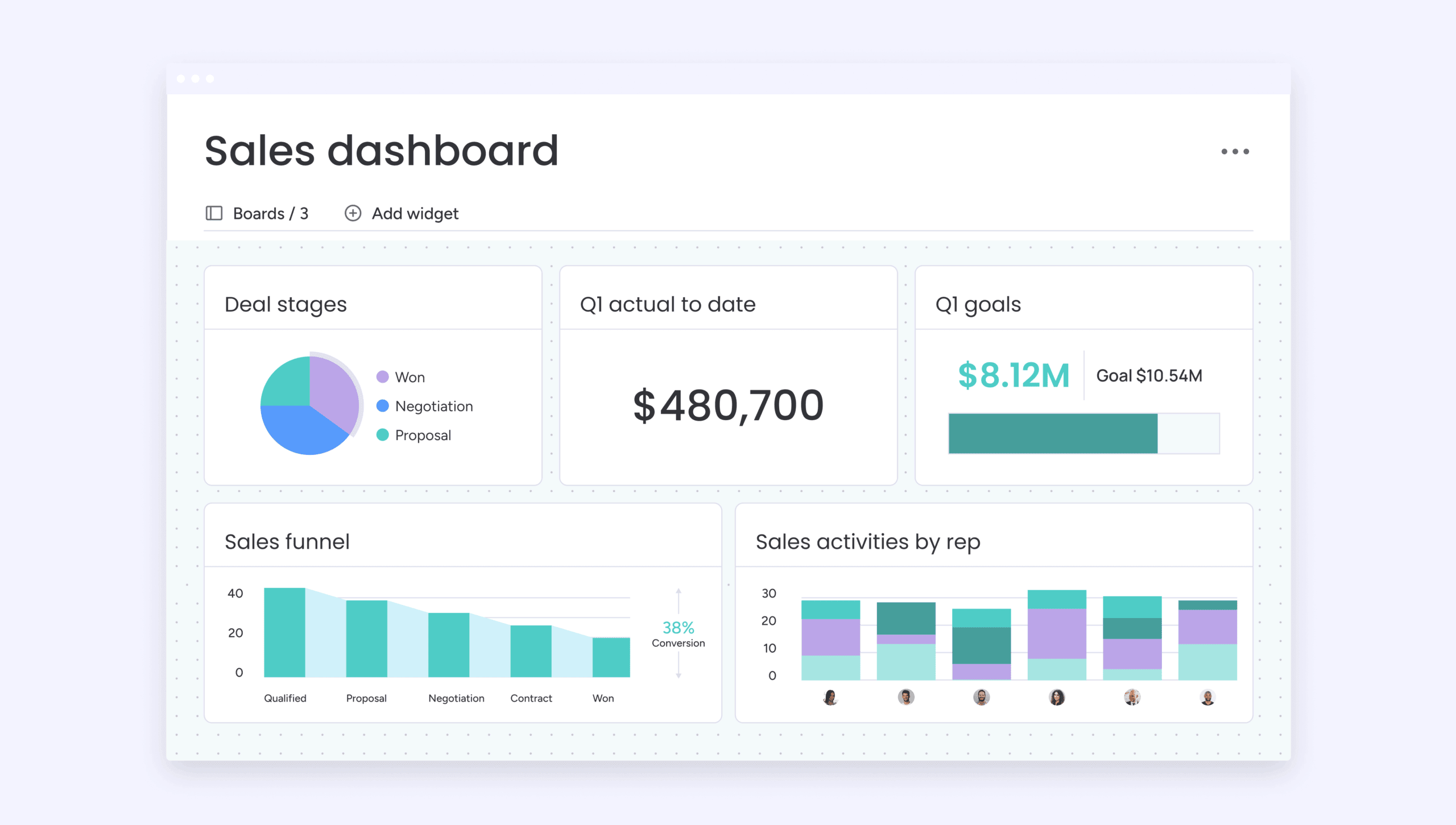
Built-in dashboards can be completely customized with widgets and different visuals to make it quick and easy to see real-time customer satisfaction trends and statistics at one glance. With AI, teams can also predict churn risk based on real-time customer data and behavior analysis. These predictive insights allow teams to work quickly and proactively to continue delivering a cohesive and positive customer experience.
Best practices for measuring customer satisfaction: Turning data into loyalty
Building a customer satisfaction strategy isn’t a simple feat. Just because a business has data on customer satisfaction doesn’t always mean it can easily translate it into an action plan. Improving how your business measures customer satisfaction, to start with, is a good way to influence how it works with the data to implement change. Here are a few best practices to follow to make the most of customer satisfaction tracking.
- Don’t rely on a single feedback channel: Combine surveys, social media monitoring, support ticket analysis, and direct conversations to get a comprehensive view of customer satisfaction. Different methods capture different types of insights and reach different customer segments.
- Ask the right questions at the right time: Timing matters, so it’s important to send surveys after key interactions like purchases or support calls when the experience is fresh in customers’ minds. Keep questions clear, concise, and specific to their recent experience.
- Track metrics over time: Measuring customer satisfaction isn’t a one-and-done event. Establish a regular cadence for measuring satisfaction so that you can consistently identify trends, measure change impact, and benchmark performance across different time periods.
- Reduce friction in the feedback process: Keep your feedback forms short, focused, and make participation as simple and enticing as possible. Long, complicated surveys may lead to low response rates and biased results from only your most engaged or frustrated customers.
- Balance quantitative and qualitative data: Combine satisfaction scores with open-ended responses, customer interviews, and detailed comments to understand the story behind the numbers and identify root causes of satisfaction or dissatisfaction.
- Train your team to interpret feedback: Empower your team with the knowledge and training they need to make the most of incoming feedback. Misinterpretation can lead to wasted resources, so it’s important that your team can properly interact with customer satisfaction data.
Implement strategic customer tracking to improve customer experience
Strategic customer tracking helps businesses move from assumptions to insight. By understanding how customers behave, feel, and progress across their journey, teams can make smarter decisions and deliver more consistent experiences. With a platform like monday CRM, businesses can combine real-time data, AI-driven analysis, and flexible workflows to turn customer insights into meaningful action at every stage of the customer lifecycle.
Try monday CRMFAQs
What is a customer tracking system, and what key features should it have?
A customer tracking system is software that monitors and analyzes customer interactions, behaviors, and feedback across multiple touchpoints. This software includes features like real-time data collection, sentiment analysis capabilities, customizable dashboards, integration with existing tools, automated reporting, and the ability to segment customers by demographics or behavior patterns for targeted insights.
What is the importance of customer satisfaction for long-term business growth?
Customer satisfaction directly impacts revenue growth through repeat purchases, higher lifetime value, and reduced churn rates. Satisfied customers become brand advocates who drive new business through referrals and positive reviews. Additionally, retaining existing customers costs significantly less than acquiring new ones, making satisfaction a critical factor in sustainable profitability and competitive positioning.
How does tracking the customer journey differ from tracking individual feedback?
Customer journey tracking maps the entire experience across multiple touchpoints from awareness to post-purchase, revealing how satisfaction evolves over time. Individual feedback captures specific moments or interactions. Journey tracking identifies patterns, bottlenecks, and cumulative effects, while individual feedback provides detailed context about particular experiences. Both approaches complement each other for a comprehensive understanding.
What steps are involved in successfully implementing a real-time customer experience tracking program?
To implement a successful real-time customer experience tracking program, start by defining clear objectives and key metrics aligned with your business goals. Next, select the tracking tools that align with your business goals and integrate them across all customer touchpoints. After that, you’ll want to train teams on data interpretation and response protocols, and then establish automated alerts when your system detects negative sentiment or when satisfaction levels drop. Finally, regularly review metrics, adjust strategies based on findings, and communicate improvements to customers.
How does AI improve customer satisfaction and experience tracking?
AI enhances customer tracking by analyzing large volumes of behavioral and sentiment data in real time. Instead of relying solely on surveys or manual reviews, AI can detect patterns, predict churn risk, surface emerging issues, and prioritize customers who need immediate attention. This allows teams to respond faster, focus on the highest-impact actions, and continuously improve the customer experience.
What’s the difference between real-time customer experience tracking and traditional surveys?
Traditional surveys capture feedback at specific moments, often after an interaction has already occurred. Real-time customer experience tracking monitors behavior and sentiment as they happen, using signals like product usage, support interactions, and communication tone. This real-time visibility helps teams intervene earlier, resolve issues proactively, and prevent dissatisfaction from escalating into churn.
Which customer satisfaction metrics matter most at different stages of the customer journey?
Different stages of the customer journey call for different metrics. Early-stage interactions often benefit from engagement and onboarding feedback, while ongoing relationships rely more on metrics like CSAT, CES, and usage trends. Later stages may emphasize NPS, retention, and churn indicators. Tracking the right metrics at each stage helps teams understand how satisfaction evolves over time and where targeted improvements will have the greatest impact.
 Get started
Get started 

